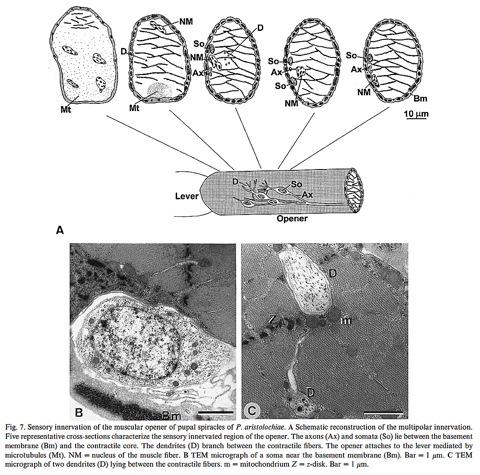Schmitz, A. and Wasserthal, L.T. (1999): Comparative morphology of the spiracles of the Papilionidae, Sphingidae, and Saturniidae (Insecta: Lepidoptera), Int. J. Insect Morphol. Embryol. 28 (1-2) pp. 13-26.
The morphology, ultrastructure, and innervation of the spiracles of the instars and adults of representatives of three lepidopteran families were examined: Ornithoptera priamus poseidon and Pachliopta aristolochiae (Papilionidae), Attacus atlas (Saturniidae), and Acherontia atropos (Sphingidae). Peritreme and atrium show stage! and family-specific structures for protecting the internal valve apparatus. The gross morphology of the cuticular valve mechanism is uniform within the three families, consisting of a rigid bow and a movable bar with a lever. In adult Papilionidae, all cuticular parts (bow, bar and lever) of the valve are innervated by multipolar dendrites. Internal or external cuticular chemo- or hygroreceptors, which could participate in the regulation of respiration, could not be detected in any stage. The closing muscle inserts between the tip of the lever and the base of the bar, and is innervated only by motor neurons. The elasticity of the cuticular system and an opener are the antagonists to the closing muscle. The spiracular opener of the adult Papilionidae and of all instars of the moths is an elastic ligament. As a peculiarity the opener of the larval and pupal spiracles of the Papilionidae is a single thickened muscle fiber surrounded by an elastic sheath of connective tissue (Fig.7 below). As it contains motor and multipolar sensory neurons, we assume that it may function as a stretch receptor for controlling the spiracular opening state.


